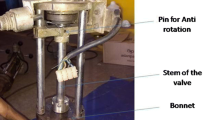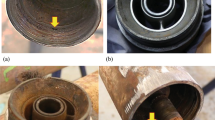Abstract
Pumps are a key and crucial part of many industrial units which usually are endangered by metallurgical, mechanical, and chemical damages. The most important mechanisms of failure in pumps are cavitation, erosion, and corrosion which directly are influenced by pump’s materials, type of fluent, and operation condition. The aim of this study was to investigate the role of material selection in the main failure mechanisms of a power plant booster pumps. To observe the kind and micro structure of pumps optical microscopy and image analyses software were used. Morphology of the pumps’ body is investigated by scanning electron microscopy. Electrochemical tests and water analyses are done for measurement of corrosion rate as well as amount of particles in feed water. Moreover, tensile testing was carried out to compare the mechanical properties of body alloy with standard alloy. The results revealed that cavitation and erosion were the most significant mechanisms. On the other hand, the data from analyses and observations clarified that the material which chosen for pumps alloy was improper which was accompanied with lack of fabrication technology.









Similar content being viewed by others
References
Cudina, M., Prezelj, J.: Detection of cavitation in operation of kinetic pumps. Use of discrete frequency. Appl. Acoust. 70, 540–546 (2009)
Escaler, X., Egusquiza, E., Farhat, M., Avellan, F., Coussirat, M.: Detection of cavitation in hydraulic turbines. Mech. Syst. Signal Process. 20, 983–1007 (2006)
Sherier, L.L., Jarman, R.A., Burstein, G.T.: Corrosion, vol. 1, 3rd edn. Heinemann, Butterworth (1994)
Dular, M., Stoffel, B., Sirok, B.: Development of a cavitation erosion model. Wear 261, 642–655 (2006)
Dular, Matevz., Osterman, Aljaz.: Pit clustering in cavitation erosion. Wear 265, 811–820 (2008)
Hart, D., Whale, D.: A Review of Cavitation-erosion Resistant Weld Surfacing Alloys for Hydroturbins, pp. 981–995. IIW Asian Pacific Welding Congress, the New Zealand Welding Committee, (1996)
Karassik, I.J., Messina, J.P., Cooper, P., Heald, C.C.: Pump Handbook, 3rd edn. McGraw-Hill, New York (2001)
Sastri, V.S., Ghali, E., Elboujdaini, M.: Corrosion Prevention and Protection Practical Solutions., p. 393. Wiley, New York (2007)
Sulzer Pumps Ltd: Centrifugal Pump Handbook, 3rd edn. Elsevier Ltd., Houston (2010)
Ariely, S., Khentov, A.: Erosion corrosion of pump impeller of cyclic cooling water system. Eng. Fail. Anal. 13, 925–932 (2006)
Dojcinovic, M., Volkov-Husovic, T.: Cavitation damage of the medium carbon steel: implementation of image analysis. Mater. Lett. 62, 953–956 (2008)
Ahmad, Z.: Principles of Corrosion Engineering and Corrosion Control, p. 252. Elsevier, Washington (2006)
Hattori, S., Ishikura, R., Zhang, Q.: Construction of database on cavitation erosion and analyses of carbon steel data. Wear 257, 1022–1029 (2004)
Nalco Chemical Company: The NALCO Water Handbook, 2nd edn. McGraw-Hill Book Company, New York (1988)
Haosheng, C., Jiadao, W., Darong, C.: Cavitation damages on solid surfaces in suspensions containing spherical and irregular microparticles. Wear 266, 345–348 (2009)
Lathabai, S., Ottmüller, M., Fernandez, I.: Solid particle erosion behaviour of thermal sprayed ceramic, metallic and polymer coatings. Sci. Technol. 221, 93–108 (1998)
Sun, Z., Kang, X.Q., Wang, X.H.: Experimental system of cavitation erosion with water-jet. Mater. Des. 26, 59–63 (2005)
API STANDARD 610: Centrifugal Pumps for Petroleum, Petrochemical and Natural Gas Industries, 9th edn. American Petroleum Institute, Washington (2003)
ASM Handbook, Vol. 18: Friction, Lubrication, and Wear Technology. American Society for Metals (1992)
Wegst, C.W.: Key to Steel: Stahlschlussel (English Edition). Verlag Stahlschussel, Heidelberg (2007)
Author information
Authors and Affiliations
Corresponding author
Rights and permissions
About this article
Cite this article
Alavi Shoushtari, A., Ranjbar, K., Mousavi, S.M. et al. Study on Failure Analyses and Material Characterizations of a Damaged Booster Pump. J Fail. Anal. and Preven. 13, 489–495 (2013). https://doi.org/10.1007/s11668-013-9704-3
Received:
Revised:
Published:
Issue Date:
DOI: https://doi.org/10.1007/s11668-013-9704-3




